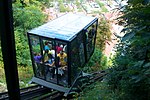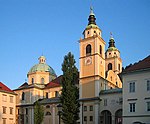Dragon Bridge (Ljubljana)
20th-century architecture in SloveniaArch bridges in SloveniaArt Nouveau architecture in LjubljanaArt Nouveau bridgesBridges completed in 1901 ... and 6 more
Bridges in LjubljanaBridges over the LjubljanicaCenter District, LjubljanaConcrete bridgesRoad bridges in SloveniaSculptures of dragons

The Dragon Bridge (Slovene: Zmajski most, historically also Zmajev most) is a road bridge located in Ljubljana, the capital of Slovenia. It crosses the Ljubljanica River. between Kopitar Street (Kopitarjeva ulica) and Ressel Street (Resljeva cesta), to the north of the Ljubljana Central Market at Vodnik Square. It was built in the beginning of the 20th century, when Ljubljana was part of the Austro-Hungarian Empire. As one of the best examples of reinforced concrete bridges and of the Vienna Secession style, the bridge is today protected as a technical monument. It is intended primarily for motorised traffic.
Excerpt from the Wikipedia article Dragon Bridge (Ljubljana) (License: CC BY-SA 3.0, Authors, Images).Dragon Bridge (Ljubljana)
Resljeva cesta, Ljubljana Trnovo
Geographical coordinates (GPS) Address Website External links Nearby Places Show on map
Geographical coordinates (GPS)
| Latitude | Longitude |
|---|---|
| N 46.051947 ° | E 14.510241 ° |
Address
Zmajski most
Resljeva cesta
1104 Ljubljana, Trnovo
Slovenia
Open on Google Maps








